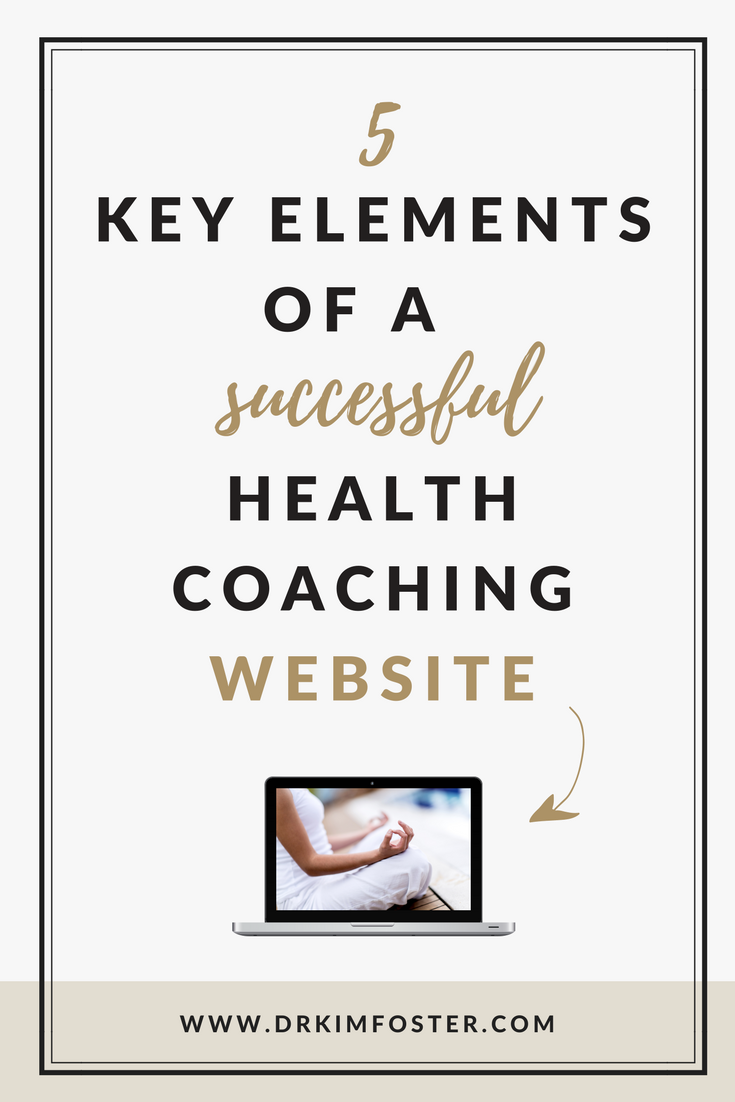Do you have a website for your health coaching business? If you’re a health coach, whether you do business online, in-person, or a blend of the two, a website is a critical piece of marketing.
Especially these days, it’s not difficult or expensive to set up a website. Of course, if you’re not technically inclined, you can hire someone to help you out with this, but if that’s not in the budget just yet, the truth is you could probably figure it out yourself and DIY it…even just to get started.
Either way — DIYing it or hiring a developer/designer — you’re going to need to know which components your site will need.
Below is a list of the five basic things every health coach’s website needs. As your business grows, you can always add to this and get fancier, but this will get you started.
Element #1: Your home page
The primary job of your home page is to connect with your ideal client.
For starters, your home page needs an attractive header. Usually this is a combination of your logo and a banner image, but it’s important to go with what works for you. Maybe you want your banner to be a slider, with a couple of images that slide across, to give a quick snapshot of your business. Maybe you want something simpler, cleaner. Maybe you want to have a video feature prominently. Either way, it’s important that your home page clearly conveys your image and niche and WHAT YOU DO, and it needs to be on-brand (for more help with this, see my recent article on branding).
When designing your home page, it’s critical to have a clear idea of your ideal client avatar, so you can speak to them directly and maximally appeal to them. Ask yourself: does your site immediately connect with your ideal potential client? Or better yet, ask someone else (someone who represents your ideal target market, ideally)!
Element #2: Simple navigation
The most important quality of your site’s navigation is that it be easy and intuitive. The words you use in your menu (likely across the top) need to be plain and universally understood. So no fancy, flowery words that people may not understand.
Choose clear labels for menu items: terms like “about” and “programs” or “services”. Resist the urge to go with something flashy or obscure.
Element #3: A method of capturing leads
This should be a primary focus of your website. If you’re in business as a health coach, you need to begin building an email list, and the sooner, the better. And one of the best ways to do this is to have some kind of call-to-action right on your homepage, ideally above the fold (in the top screen before people have to scroll down).
The call-to-action must be a method for people to opt-in, and it can be a simple pop-up or “learn more” button, or an offer to grab a freebie or some other opt-in lead magnet. Whatever works for you and your particular niche, but you need to make it quick and easy, right on the first page your visitors will encounter.
Element #4: Your “about” page
Writing your about page is an art form. The most important thing to keep in mind is that this page is not actually about YOU. Granted, people who click “about” on your website are probably curious about you, to a certain extent…but most likely, what they *really* want to know is: how can you help them? Are you the right person to solve their problems? Are you the person they’ve been looking for?
So those are the questions you need to address in your about page. Start with an amazing headline that captures interest or asks a question. Then immediately go into a short piece about the struggle they’re likely having, and how you are the exact person to help with that struggle. Of course, this all requires that you have a very clear idea of who your ideal client avatar is (the subject of this previous post).
Element #5: A listing of your services or programs
Depending on the nature of your coaching business, you might use different titles for this page (it could be “services” or “programs” or “courses”), but basically, you need to have a clear way for people to WORK WITH YOU. You’re in business, after all, so you want to make it easy for people to see your services or offerings.
Break it down into packages if you like, or just keep it simple. But whatever you do, don’t make people guess about this. They need to know what it would look like to work with you, how much it costs, etc. Maybe they’re not in a position to buy right now, in which case this will serve as a planted seed. If they’re interested enough in you and your work, if they are a good fit ((ie. if they’re your ideal client), if they like what they see, then there’s a good chance they’ll opt in (see element #3) and become a member of your community/email list. But it’s also important for them to know that you are available for coaching, so they will think of you when that need actually arises and they’re ready.
On the other hand, someone who lands on your site may already be primed and looking for a coach. If they like you and they want to pursue working together right away–don’t make it hard for them!
Be sure you have a simple contact form clearly visible, or some other way for people to get in touch with you. Again, don’t make people hunt for this.
Let’s Recap!
Okay, so there you have it. The five key components you need to have on a website that works for your health coaching business:
- A home page that connects with your ideal client
- Simple, clear navigation
- A method of capturing leads
- Your “about” page
- A listing of your programs/services
One important reason to have your website tiptop shape is if you intend to get referrals to your health coaching business–which, in my opinion, is one of the BEST and most powerful ways to get a reliable flow of clients.
When pitching professionals, like doctors, for referrals, you have to know they will be checking you out online if they intend to send their patients your way–and you need to have a professional-looking website.
Now, if you’re interested in learning more about how to get referrals, check out my free downloadable guide.
Good luck with creating your new website–and HAVE FUN!






